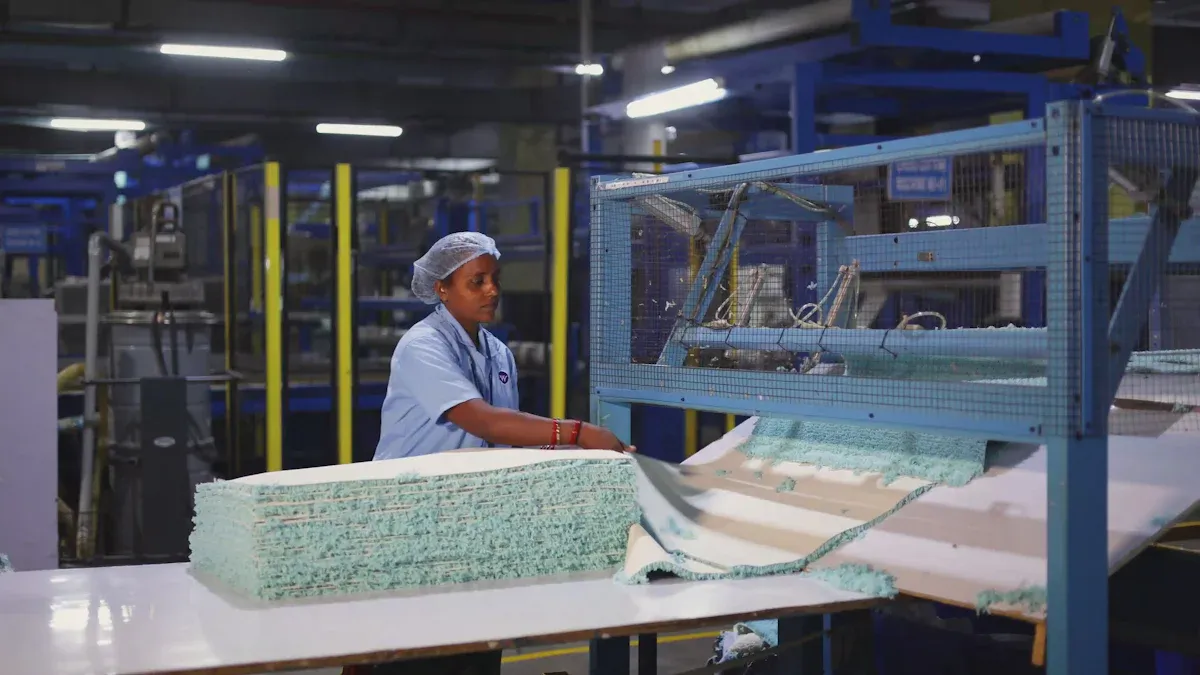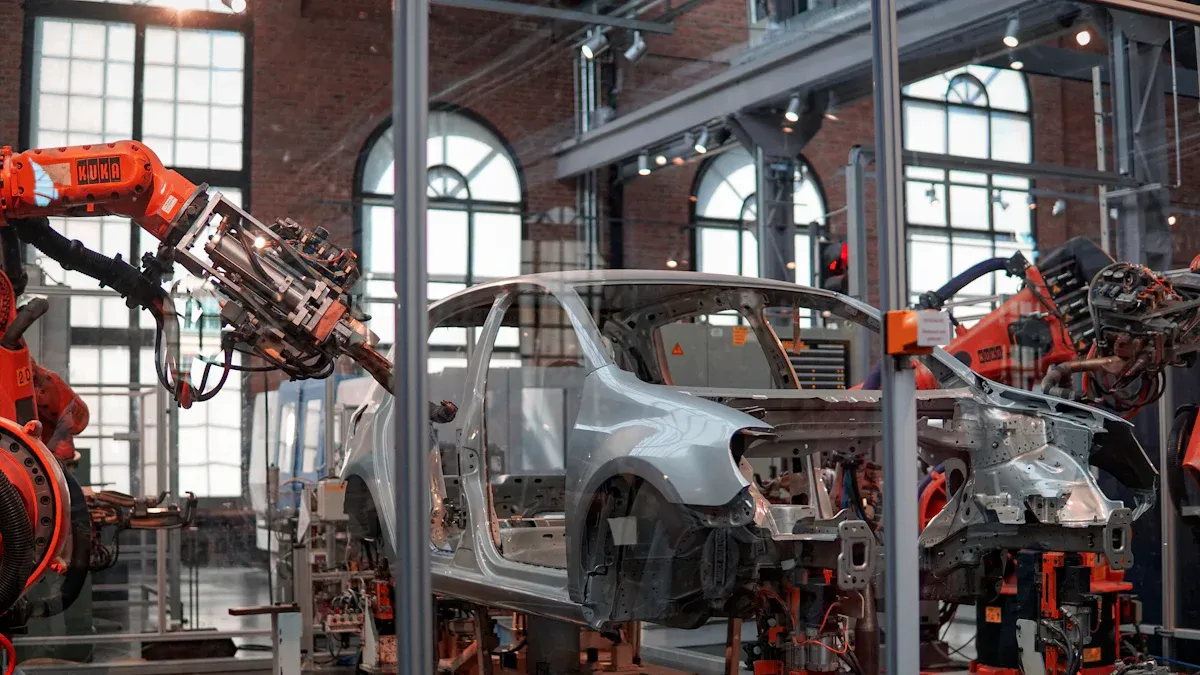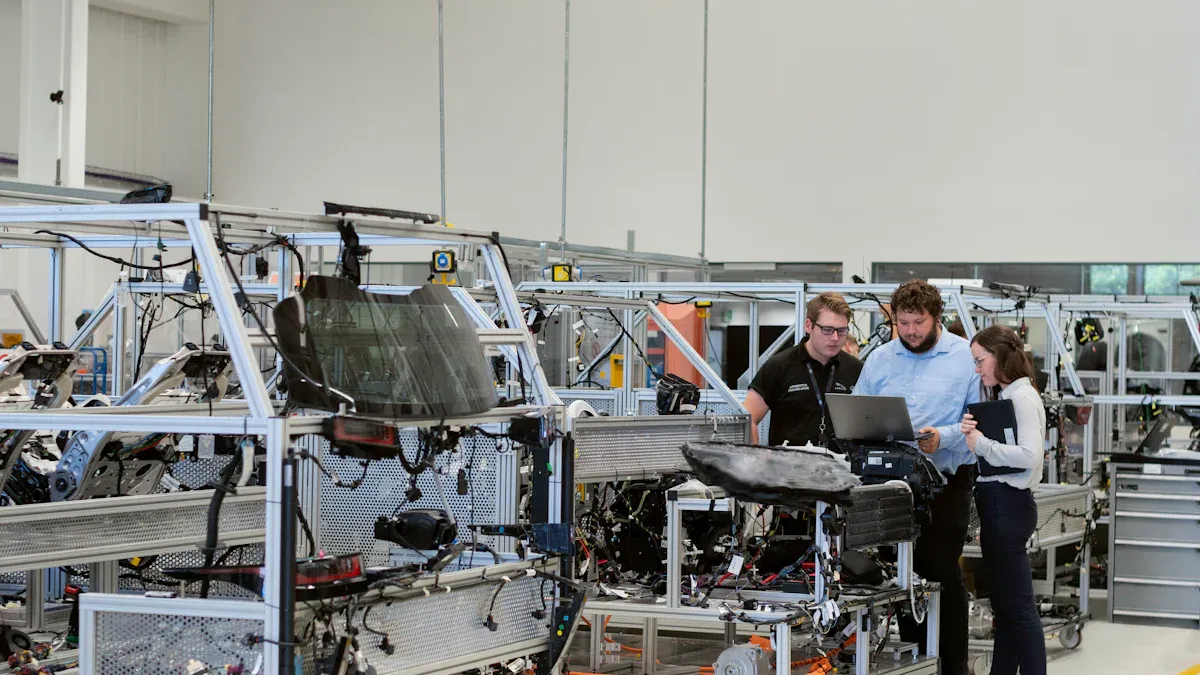What is SMED in Lean Manufacturing and Why Does It Matter Today

SMED, which stands for Single Minute Exchange of Die, is a fundamental concept within SMED lean manufacturing. It focuses on significantly reducing changeover times. In 2025, factories face intense competition and frequently switch products, creating pressure to maximise output. SMED lean manufacturing techniques enable factories to change products swiftly. Changeover times can be reduced from 90 minutes to under 5 minutes, representing a 94% reduction observed in numerous instances. For example, an injection moulding plant reduced its changeover from two hours to just 18 minutes, resulting in a 15% increase in machine uptime. These outcomes allow teams to respond more rapidly to market shifts and improve overall efficiency. SMED lean manufacturing provides clear, actionable steps for tangible and measurable improvements.
SMED Lean Manufacturing

What is SMED?
SMED, or single minute exchange of die, is a key method in smed lean manufacturing. This way helps factories switch from one product to another faster. The smed process tries to do as many changeover steps as possible while machines are still working. This saves time and helps teams use machines better.
The main goals of smed lean manufacturing are:
Cut downtime so machines work more.
Make more products by waiting less.
Use smaller batches to react quickly to customers.
Keep less stock, which saves space and money.
Make changeovers the same each time to improve quality.
Spend less by using resources better.
The smed process has three main steps:
Separate: Find out which jobs need the machine stopped (internal) and which can be done while it runs (external).
Convert: Change as many internal jobs as possible into external ones.
Streamline: Make the last internal jobs quicker and easier.
Tip: Factories using the smed process often cut changeover times from hours to just minutes. This makes them more flexible and able to compete better.
Origins and Principles
The single minute exchange of die method started in Japan in the 1950s. Shigeo Shingo, who worked with Toyota, made this method to help factories cut long changeover times. He wanted to support just-in-time production, which means making things only when needed.
The table below shows important facts about the start and rules of smed lean manufacturing:
Aspect | Details |
|---|---|
Origin | Made in Japan in the 1950s by Shigeo Shingo, a Toyota consultant, to cut changeover times and help just-in-time production. |
Key Historical Example | Changeover time for a 1,000-ton press at Toyota went from 4 hours to 3 minutes. |
Foundational Principles | 1. Find and split jobs into internal (done when machine stopped) and external (done while running). |
Definition of "Single Minute" | Means getting changeover times to less than 10 minutes, not under 60 seconds. |
Broader Application | SMED methods work for many industries and types of changeovers, not just dies. |
The rules of smed lean manufacturing are about making changeovers fast and easy. Factories split jobs into internal and external, then try to move as many as they can to external. They use templates and set places to stop errors and speed up work. Making the smed process the same each time helps new staff learn and keeps results steady.
Now, smed lean manufacturing is used in many industries, not just car factories. Companies use the single-minute exchange of dies method for things like changing flavours in food or switching packaging. The smed process lets factories make lots of products without wasting time or money.
Single Minute Exchange of Die Benefits
Reducing Changeover Time
SMED is a strong way to cut changeover time. Companies using SMED often see big changes. When they use both organisational and technical ways, changeover time drops by almost 59%. The table below shows how each way helps:
Improvement Strategy | Average Reduction in Changeover Time (%) | Additional Notes |
|---|---|---|
Mixed strategy (organisational + technical) | ~59% | Popular among medium-large companies; balances cost and time efficiency |
Technical improvements only | >55% | High initial cost but financially viable mid to long term; accounts for 84% of total reduction |
Procedural/organisational improvements only | <50% | Lower investment; less reduction achieved |
Cutting changeover time gives many clear benefits: 1. Less downtime means more time to make things. 2. Labour and overhead costs go down as workers spend less time setting up. 3. Companies can react faster to what customers want. 4. Shorter changeovers help deliver products quicker and make customers happier.
Saving time during changeover makes factories work better. For example, if a factory cuts changeover from 90 minutes to 15 minutes, it saves over 300 hours each year. This can mean hundreds of thousands of pounds in extra value. SMED helps by saving time, lowering costs, and using resources better.
Flexibility and Productivity
The single minute exchange of die method makes factories more flexible. SMED lets them switch products quickly, so they can keep up with market changes. For example, Precision Auto Components cut changeover from 90 minutes to 15 minutes. This helped them make more products and take more orders.
SMED helps factories work better by making changeovers fast and steady. Teams can make tasks the same, train staff easily, and make fewer mistakes. Cutting changeover time also keeps machines running longer and reduces waste.
Main SMED benefits for factories are: - More productivity because machines run more. - Better flexibility to change products fast. - Higher quality with fewer mistakes during changeover. - Happier customers because products arrive sooner.
Note: SMED and the single minute exchange of die help companies stay ahead by making work faster and helping them react to changes in the market.
Steps to Implement SMED

Preparation and Team
Good SMED projects begin with careful planning. The right team is important. Companies pick areas where changeovers happen a lot. They check how long changeovers take now. This gives them a starting point. Teams then set goals to improve these times.
A team with people from different jobs works best. This team has staff from production, maintenance, engineering, supply chain, and finance. Each person has a job to do. The manager leads the project and sets targets. The manager also arranges training. Supervisors run workshops and make sure rules are followed. Operators do the changeover and share ideas. Maintenance staff help with tools and machines. Supply chain staff get materials ready on time. Finance checks costs and savings.
Role | Responsibilities |
|---|---|
Manager | Begins the SMED project, sets goals, picks the team, arranges training, and checks progress. |
Supervisor | Runs SMED workshops, leads brainstorming, and checks that everyone follows the new changeover process. |
Operator | Gets ready for changeovers, does them, follows instructions, and helps train others. |
Maintenance | Builds or fixes tools and machines needed for faster changeovers. |
Supply Chain | Makes sure all materials and tools are ready before the changeover starts. |
Finance | Tracks costs and savings to show the value of the SMED project. |
Tip: A SMED champion often leads the team. This person knows the process well and keeps everyone focused.
The team watches and records the current changeover. They use videos and time checks to find delays. After this, they train all staff on the new SMED steps. This helps everyone understand the changes.
Internal vs External Tasks
A key step in SMED is splitting tasks into internal and external. Internal tasks need the machine to stop. These include removing guards or changing tools. External tasks can be done while the machine runs. These include getting new tools or preparing materials.
Task Type | Common Examples |
|---|---|
Internal Tasks | Removing guards, taking out old tools, placing new tools, connecting air, clearing feeders |
External Tasks | Fetching new tools, returning old tools, finding paperwork, getting raw materials |
SMED tries to move as many internal tasks as possible to external ones. For example, workers can get tools ready before stopping the machine. This change cuts changeover time and keeps machines running longer. By making this split, companies cut downtime and improve the whole process.
Note: Changing internal tasks to external ones is key. It helps reduce setup time and boosts productivity.
Standardising Changeovers
Making the changeover process the same each time helps improvements last. Teams break the changeover into main parts like cleaning, setting up, and starting up. They watch each step and write clear instructions. These become standard operating procedures (SOPs) for everyone to follow.
Best ways to standardise changeovers are:
Split internal and external activities.
Move as many internal activities as possible to external ones.
Make every step faster and safer.
Use quick-release fasteners, colour codes, and error-proof tools.
Create visual aids like shadow boards and status lights.
Use lean methods like 5S to keep the area tidy.
Train all staff on the new SOPs.
Check and update procedures often to keep improving.
Callout: Digital tools like tablets and QR codes help operators find the latest instructions quickly.
Standardisation means every operator does the changeover the same way. This lowers mistakes and keeps changeover time short. Regular training and checks help keep these standards.
The Six Fundamental Steps of SMED
SMED uses a clear method to cut changeover time. The six main steps are:
Measure the current changeover time to set a starting point.
Watch and record the changeover, noting every step.
Split all steps into internal and external tasks.
Move as many internal tasks as possible to external ones.
Make both internal and external steps faster and better.
Write down and standardise the new process, then train everyone.
These steps help teams find wasted time and remove it. They also make sure improvements last.
Practical Example: SMED in Action
A car parts factory wanted to cut changeover time on its stamping press. The team measured the old changeover at 90 minutes. They watched the process and saw workers got tools after stopping the machine. By getting tools ready before, they made this an external task. They also used quick-release clamps to speed up tool changes. The team wrote new SOPs and trained all operators. After these changes, the changeover dropped to 15 minutes. The factory made more products and filled more orders.
Other industries see the same results. Bottling plants now change bottle sizes in under 10 minutes by getting parts ready and using automatic adjustments. Plastic moulding companies use quick-release systems and motion checks to cut downtime.
Note: The biggest problem in SMED is not taking action. Teams must organise, standardise, and look after equipment to keep changeover times low.
Overcoming SMED Challenges
Change Management
Many factories find it hard to make changeovers better. The biggest problems are not enough support, bad data, and people not liking new ideas. Teams have trouble getting everyone to help, from bosses to workers. If people do not know why changeover matters, they may get confused or say no. This can slow down progress.
A good plan for change management in SMED has some main parts:
Talk clearly about why change is needed and how faster changeover helps.
Get all workers involved so they feel part of the changes.
Give feedback and praise often to keep people working hard.
Use set ways to collect data, like timing jobs and filming, to see where time is lost.
Tip: Companies such as Toyota and General Electric show that talking openly and including workers helps stop problems and makes SMED work well.
Good data lets teams see when machines are not working during changeover. Digital tools and live tracking help find issues and check progress. When everyone knows why cutting changeover time is good, they work together to keep machines running and make more products.
Training and Sustainability
Training is very important for keeping SMED changes working. Workers must learn the new steps and why each one matters. Good training uses simple guides, lists, and lots of practice. Lean Six Sigma classes and hands-on lessons help staff learn how to save time and speed up changeover.
Ongoing help keeps the process strong. Teams should check changeover times often and look for ways to get better. Regular checks and meetings help spot problems. Letting workers share ideas keeps SMED fresh and useful.
Training Element | Benefit |
|---|---|
Clear work instructions | Fewer mistakes during changeover |
Regular audits | Keeps downtime low and standards high |
Employee empowerment | Brings new ideas for faster changeover |
Leadership commitment | Shows changeover improvements matter |
Note: One car parts company cut changeover from three hours to under one hour by training staff and checking work with video.
Keeping SMED going means making changeover better every day. Teams that focus on training, feedback, and support from leaders keep downtime low and stay ahead in a busy market.
SMED is still very important in lean manufacturing for 2025. Companies using SMED work faster and make fewer mistakes. They also finish orders more quickly. SMED helps factories deal with supply chain problems and not enough workers. It does this by making changeovers quicker and easier. Teams see machines used more and products made better right away. Getting better all the time becomes normal at work. Factories that use SMED now can change plans easily and stay ahead when things change.
FAQ
What does "single minute" mean in SMED?
"Single minute" means the team tries to finish a changeover in under ten minutes. It does not mean less than one minute. This target helps factories work faster and stay ready for changes.
Can SMED work in industries outside car manufacturing?
Yes, SMED is used in many industries. Food, packaging, and electronics companies use SMED to make changeovers quicker. Any business that needs to switch products fast can use SMED.
What tools help with SMED?
Teams often use stopwatches, video cameras, and checklists. These tools help them see how long things take and find slow steps. Digital tablets and QR codes help workers follow instructions.
What is the biggest mistake when starting SMED?
Mistake | Impact |
|---|---|
Skipping team training | Staff might not do new steps |
Teams cannot see if they improve |
Teams should always train staff and check changeover times to keep getting better.
See Also
Understanding How QFD, FMEA And DOE Improve Manufacturing Quality
Boosting Engineering And Manufacturing Efficiency With Quick Response Methods
Statistical Process Control’s Impact On Improving Production Results
A Clear Guide To Measurement System Analysis For Quality Assurance
An Easy Explanation Of Total Productive Maintenance Benefits
About Hunan Puka
Established in 2016 and based in Hunan, China, with a liaison point in Berlin, we are a Tier 2 supplier for the automobile industry. We specialize in the production of customized aluminum die-casting parts designed for machines with a closing force ranging from 280 to 1250 tons, with subsequent manufacturing process CNC machining and surface treatment. Our commitment to quality is reflected in our accredited quality management system, certified by ISO9001:2015 and IATF16949:2016 standards.


